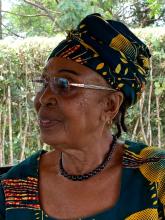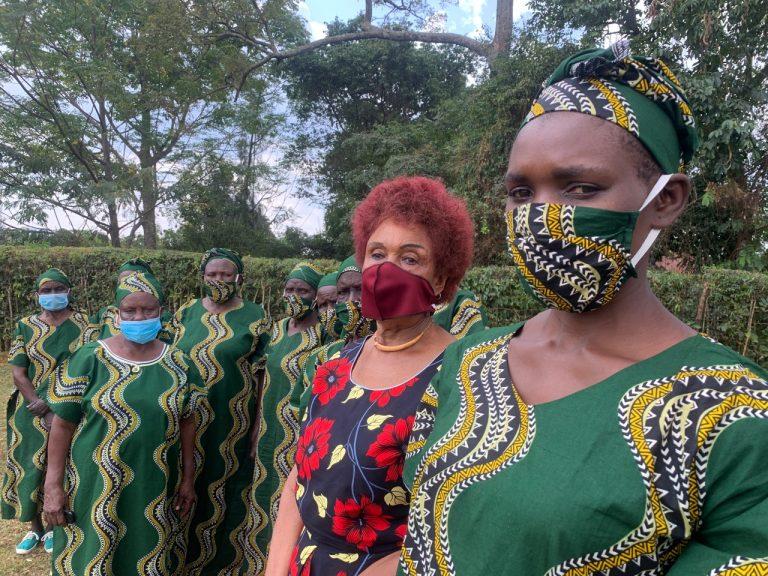Raising awareness of how public health and social measures can protect against COVID-19 and increasing trust in the vaccine are crucial steps to ending the pandemic, especially in communities where misinformation circulates and creates mistrust in systems.
Low uptake of the COVID-19 vaccine prevents the effective control of COVID-19, and is especially concerning for society’s most vulnerable members. Reaching out to communities enhances equity in access and promotes universal health coverage.
People better understand how to observe public health and social measures during the pandemic, and there is now greater trust in the COVID-19 vaccine, with uptake increasing nearly five-fold.
Working closely with County Health Management Teams, WHO provided technical support for advocacy, risk communication and social mobilization to improve vaccine uptake throughout communities across Kenya.

“Effective mobilization, partner coordination, programme integration and a dual vaccine delivery approach are key lessons from this experience. WHO will continue to support PHC-oriented health system strengthening for effective delivery of services and the attainment of universal health coverage for all Kenyan populations,”

“It was unfortunate that community understanding about the COVID-19 vaccine was shrouded in myths and misconceptions, and uptake was very slow.”

“When the COVID-19 vaccination was introduced, I heard people say it will kill older people. I was afraid. But I have now been well-informed and I have also seen that those who were vaccinated earlier did not die. I want to go for vaccination. And today, I heard WHO say that when one is vaccinated and gets the disease, it will not be severe enough to cause death.”
The Long Read
Like many other people in Siaya County, Western Kenya, Margaret Awino, a member of the Doho Ukwaka Magombe Masat Association (DUMMA) women group, was fearful of receiving the COVID-19 vaccine due to negative rumours circulating in the community.
“When the COVID-19 vaccination was introduced, I heard people say it will kill older people. I was afraid. But I have now been well-informed and I have also seen that those who were vaccinated earlier did not die. I want to go for vaccination. And today, I heard WHO say that when one is vaccinated and gets the disease, it will not be severe enough to cause death,” said Margaret.
Engaging local communities to support the COVID-19 response and accept the vaccine has been a core part of the Government of Kenya’s response to COVID-19. This is something that WHO, with support from a Canadian grant through the UHC Partnership, has been supporting strongly. Efforts have focused on mobilizing local leaders, including government officials, women and youth groups, religious leaders, and even taxi drivers to counter myths and misinformation, as well as undertaking risk communication.
Kenya is among the 115 countries and areas to which the UHC Partnership helps deliver WHO support and technical expertise in advancing universal health coverage (UHC) with a primary health care (PHC) approach. The Partnership is one of WHO’s largest initiatives on international cooperation for PHC and UHC. It is funded by the European Union (EU), the Grand Duchy of Luxembourg, Irish Aid, the Government of Japan, the French Ministry for Europe and Foreign Affairs, the United Kingdom – Foreign, Commonwealth & Development Office, Belgium, Canada and Germany.

DUMMA women’s group in Siaya County
@WHO/John Kisimir
Creating demand for COVID-19 vaccinations
When Kenya launched the COVID-19 vaccine, the County of Kisumu in Western Kenya received an initial 15,000 doses and took action to vaccinate the population as quickly as possible.
“At that time, it was unfortunate that community understanding about the COVID-19 vaccine was shrouded in myths and misconceptions, and uptake was very slow,” said Dr Gregory Ganda, Acting County Executive Member for Health, Kisumu County.
The situation was further complicated by the fact that the COVID-19 vaccine was targeted at adults, who were expected to present themselves at designated health facilities. This was a new experience for Kenyans who are more familiar with childhood vaccination drives against diseases like polio and measles.
With technical support from WHO and other partners, the Kisumu County Health Management Team formed a County COVID-19 vaccine roll-out task force, which aimed to produce innovative ways to reduce vaccine hesitancy in the community. WHO, through the UHC Partnership, provided technical support for advocacy, risk communication and social mobilization to improve vaccine uptake and increase equity through community outreach campaigns.
WHO worked with the County Health Management Team to develop key messages that were aired by local radio stations. The messages targeted key priority groups, such as older people and health workers, to raise awareness and provide information about where to receive vaccines during special outreach drives. WHO also trained members of the 7 Sub County Health Management Teams on skills and techniques to conduct community dialogues with the goal of improving community understanding and acceptance of the vaccine. In addition, local stakeholders such as the County Director of Education, County Commander, Interfaith Council, County Teachers Service Commissioner and the County Police Commander were engaged to support the vaccination drive.
“It took 12 weekly virtual meetings and 3 physical meetings bringing together all the 7 Sub County Health Management Teams with partners to review progress and address the challenges in delivering the vaccine,” said Dr Ganda.
The County Health Management Team conducted COVID-19 vaccine community outreach drives in all 7 sub-counties for one week in May 2021, integrating it with the delivery of Human papillomavirus (HPV) vaccination targeting girls aged 10 – 12 years. WHO recommends vaccinating girls of this age against HPV to reduce their risk of cervical cancer later in life. As a result of the outreach, the HPV vaccination coverage increased for HPV 1 from 4.3 percent to 36 percent and HPV 2 from 2.6 percent to 12 percent.
WHO also helped the team to carry out supervisory visits to outreach sites. A local partner, the Center for International Health, Education, and Biosecurity – Kenya, supported by USAID, also played a key role by providing financial support for transport, allowances for the vaccination teams, payment to radio stations and convening review meetings.
“Effective mobilization, partner coordination, programme integration and a dual vaccine delivery approach are key lessons from this experience. WHO will continue to support PHC-oriented health system strengthening for effective delivery of services and the attainment of universal health coverage for all Kenyan populations,” said Dr Juliet Nabyonga, acting Representative of the WHO Kenya Country Office.

WHO-led COVID-19 risk communication and community engagement
@WHO/John Kisimir
Before the COVID-19 pandemic, women groups in Siaya County used to meet regularly to support each other around business or other financial and social issues. However, these groups had to stop meeting as a way of avoiding social gathering to prevent the spread of COVID-19.
Marie Owino is the leader of several women’s groups with over 100 members collectively in Siaya County, that operate under the umbrella of the national Maendeleo ya Wanawake Organization. In October 2020, she took part in a meeting organized by WHO that aimed to raise awareness about the importance of protecting communities against COVID-19 and how to engage people to do so. This inspired her to start supporting the women’s groups in Siaya Country so they could better protect themselves and their communities from the impact of the pandemic.
She then mobilized 15 leaders from 7 other women’s groups in Siaya County to engage them in leading their communities to respond to COVID-19. The women recognized they could play a critical role in influencing their households to observe COVID-19 prevention measures such as hand-washing and wearing masks. They resolved to provide hand-washing facilities in every home and, as a sign of commitment, they made fabric facemasks that matched each group’s uniform.
“We are grateful that no member of the women group has suffered or succumbed to the COVID-19 disease to date and thank WHO for engaging us as women,” said Marie.
Through the UHC Partnership, WHO provided technical and financial support to the Siaya County Health Management Team to engage local political, social and administrative leaders as part of the COVID-19 response. Together, they reviewed the COVID-19 situation. The leaders then committed to take action and encourage communities to comply with public health and social measures.
After an initial meeting with local leaders, WHO and the Siaya team further engaged a range of community groups including women groups, youth groups, boda boda operators (motor cycle taxis) and religious leaders.
“Beyond COVID-19 risk communication, WHO in Kenya has invested resources in community engagement to try to better understand the facilitators and barriers that people experience in observing public health and social measures. Through dialogues with different groups, we have been able to secure their commitment moving forward,” said Dr Juliet Nabyonga.

Impact and uptake in COVID-19 vaccine
The experience of responding to COVID-19 in both Kisumu and Siaya Counties has shown that creating the demand and providing a mix of vaccine delivery mechanisms to reach key priority groups, is an effective way to improve vaccine uptake and achieve greater equity in coverage. It also shows how choice of location is key.
For example, in Kisumu County, static health facilities accounted for only 17% of doses administered, while the outreach delivery mechanisms, which used schools and community sites, accounted for 83%. This represented a 4.8-fold increase in demand and uptake as a result of the outreach programme. Uptake rose from 896 doses to 4,338 doses within the first outreach week. Using schools as vaccination site meant that more teachers were reached with the COVID-19 vaccine, and more schoolgirls were reached with the HPV vaccine. Promoting an integrated systems approach means that services are more people-centred and able to respond to health needs, supporting strong progress towards universal health coverage.
Kenya is strengthening its health system to support its COVID-19 response and protect its population from all health emergencies.
Over the past years, the Government of Kenya has been actively developing and strengthening its health care system as well as its pandemic preparedness efforts to successfully respond to public health emergencies, such as the COVID-19 pandemic. In 2017, Kenya volunteered for a Joint External Evaluation (JEE) of its capacities to prevent, detect and respond to health emergencies. The country used the results of this evaluation to help develop a National Action Plan for Health Security (NAPHS) the following year. In 2018, 2019 and 2020 Kenya submitted a review of its preparedness capacities through the State Party Self-Assessment Annual Reporting Tool (SPAR), which consists of 24 indicators needed to detect, assess, notify, report and respond to public health risks of domestic and international concern. The Government also completed two Simulation Exercises (SimEx) in 2018, two in 2019 and one in 2020, to assess and test the functional capabilities of its emergency systems, procedures and mechanisms.
To learn more, visit WHO’s Strategic Partnership for Health Security and Emergency Preparedness (SPH) Portal.
